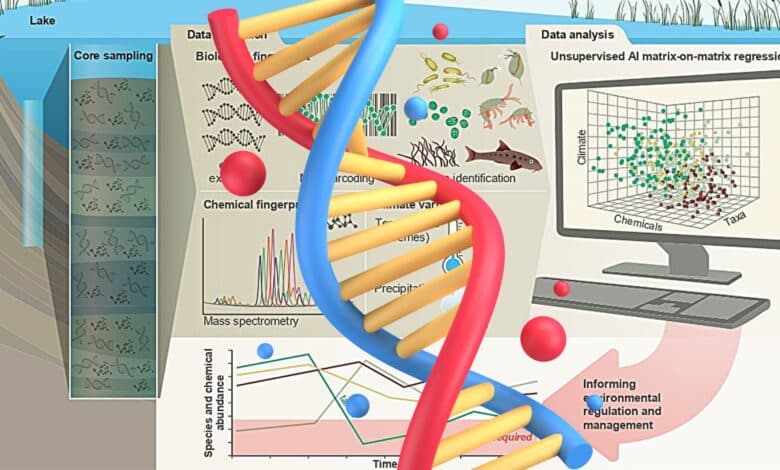Decoding a Century of Environmental Change: The Biodiversity Time Machine Unveiled

The Biodiversity Time Machine, a groundbreaking innovation, allows scientists to delve into the ecological past, providing invaluable insights into the century-long journey of environmental changes in freshwater lakes.
In a groundbreaking study, scientists from the University of Birmingham and Goethe University in Frankfurt have unveiled the first proof of concept for a revolutionary DNA ‘time machine.’ This innovative approach utilizes artificial intelligence (AI) applied to DNA-based biodiversity, climate variables, and pollution data to reconstruct a century of environmental changes in a freshwater lake.
The implications of their findings are profound, shedding light on the alarming loss of biodiversity due to factors such as warming temperatures and pollution. This article explores the methodology, discoveries, and potential implications of this research.
The Biodiversity Time Machine
The research team extracted sediment from the bottom of a lake in Denmark, known for its well-documented shifts in water quality. This sediment, essentially a biological time capsule, holds a continuous record of environmental signals spanning a century. By analyzing environmental DNA left behind by plants, animals, and bacteria, the scientists created a comprehensive picture of the freshwater community throughout the years.
AI played a crucial role in this process, assisting in the analysis of biological data along with climate and pollution information. The goal was to identify the key factors contributing to the historic loss of species in the lake, providing valuable insights into the interplay between human activities and biodiversity.
Principal investigator Luisa Orsini explains, “We took a sediment core from the bottom of the lake and used biological data within that sediment like a time machine—looking back in time to build a detailed picture of biodiversity over the last century at yearly resolution.”
The Impact of Pollution and Warming Temperatures
The findings, published in eLife, highlight the detrimental impact of pollutants, including insecticides and fungicides, coupled with a 1.2-1.5-degree increase in minimum temperature, on biodiversity levels. These factors were identified as the primary drivers of biodiversity loss over the past century.
Lead author Niamh Eastwood emphasizes the potential irreversibility of this biodiversity loss, stating, “The species found in the lake 100 years ago that have been lost will not all be able to return. It is not possible to restore the lake to its original pristine state, even though the lake is recovering.”
Despite signs of recovery in the last two decades, with improved water quality due to decreased agricultural land use, the overall biodiversity has not fully returned to its (semi)pristine phase. This poses a concern as different species play unique roles in delivering ecosystem services, and their absence can hinder the restoration of specific services.
The Role of AI in Conservation
The integration of AI into biodiversity research opens new avenues for conservation efforts. Professor Luisa Orsini emphasizes the practical applications of AI in prioritizing the conservation of species that contribute essential ecosystem services. Additionally, AI can identify key pollutants, guiding regulations to mitigate the adverse effects of chemical compounds.
Dr. Jiarui Zhou, co-lead author, highlights the value of AI-based approaches for understanding historic drivers of biodiversity loss. As the researchers move forward, they plan to expand their study to lakes in England and Wales, aiming to generalize their findings on pollution and climate change effects on lake biodiversity.
The Road Ahead: Generalizing Findings and Predicting Future Losses
The next phase of the research involves expanding the study beyond a single lake to examine the patterns observed in lakes across England and Wales. This broader scope aims to determine the replicability of the observed patterns and enhance the generalizability of the findings. By learning from the past, the researchers hope to develop holistic models that predict biodiversity loss under various scenarios, including ‘business as usual’ and other pollution scenarios.
Related article:
- A New Era of Galaxy AI is Coming — Here’s a Glimpse
- How researchers at Rice University in Texas figured out how to revive dead spiders (sort of)
- How to Create a portrait of a person from their DNA?
- Pollution: Top 5 Air Purifiers Within Budget
Conclusion
The DNA ‘time machine‘ developed by scientists from the University of Birmingham and Goethe University represents a significant leap forward in understanding the impact of human activities on biodiversity. The integration of AI into the analysis of environmental DNA provides a powerful tool for predicting, preventing, and mitigating biodiversity loss. As we face unprecedented environmental challenges, this research underscores the importance of conservation efforts guided by technological innovations and a deep understanding of our ecological history. The knowledge gained from this study not only informs regulators on protecting existing biodiversity levels but also offers hope for potential improvements in biodiversity recovery.
FAQ
Q: What is the Biodiversity Time Machine?
A: The Biodiversity Time Machine is a cutting-edge scientific approach developed by researchers at the University of Birmingham and Goethe University. It utilizes artificial intelligence and environmental DNA analysis to reconstruct a century of environmental changes, shedding light on the factors influencing biodiversity loss in freshwater lakes.
Q: How does the Biodiversity Time Machine work?
A: Researchers extract sediment cores from the bottom of lakes, containing a historical record of environmental DNA. This genetic material, left behind by plants, animals, and bacteria, serves as a biological time capsule. Artificial intelligence is then applied to analyze this data, along with climate and pollution information, to understand the dynamics of biodiversity over time.
Q: What insights has the Biodiversity Time Machine provided?
A: The Biodiversity Time Machine has revealed the significant impact of pollutants, such as insecticides and fungicides, combined with warming temperatures, on the loss of biodiversity in freshwater lakes over the past century. The research also indicates the potential irreversibility of this loss.
Q: How can AI contribute to conservation efforts through the Biodiversity Time Machine?
A: AI plays a crucial role in prioritizing conservation efforts by identifying species that contribute essential ecosystem services. Additionally, it helps pinpoint key pollutants, guiding regulatory measures to mitigate their adverse effects.
Q: Can the Biodiversity Time Machine help improve biodiversity levels?
A: While the research shows signs of recovery in some lakes, it also emphasizes that the restoration of biodiversity to its original pristine state may be challenging. However, the insights gained from the Biodiversity Time Machine can guide conservation strategies to protect and potentially enhance biodiversity recovery.
Q: What are the future plans for the Biodiversity Time Machine research?
A: The researchers plan to expand their study beyond a single lake to examine patterns in lakes across England and Wales. This broader scope aims to generalize findings on pollution and climate change effects, providing a more comprehensive understanding of their impact on lake biodiversity.
Q: How can the Biodiversity Time Machine contribute to environmental protection?
A: The Biodiversity Time Machine contributes to environmental protection by providing regulators with insights into the factors influencing biodiversity loss. This knowledge can inform policies and regulations aimed at preserving existing biodiversity levels and guiding efforts to improve biodiversity recovery.






